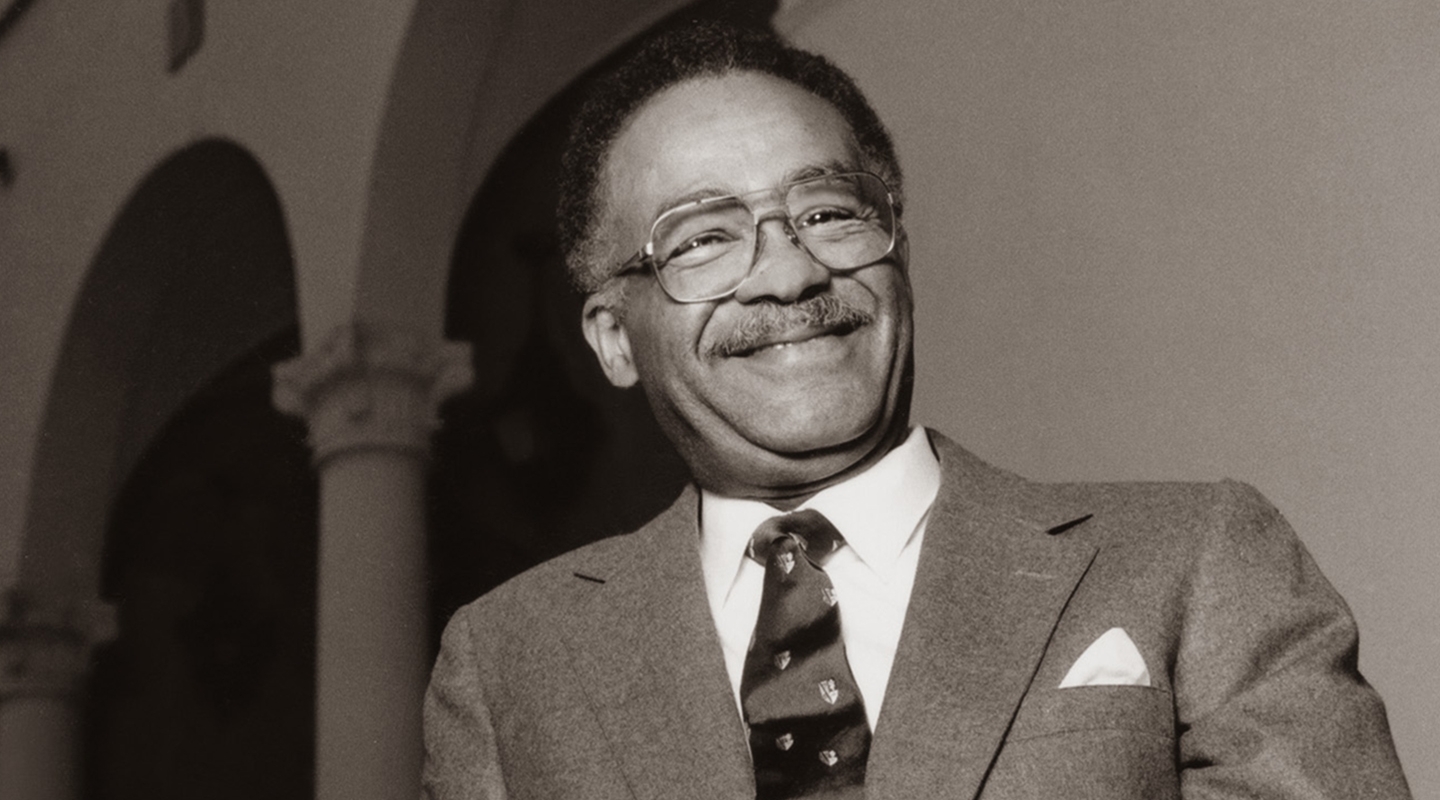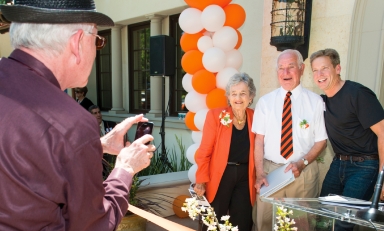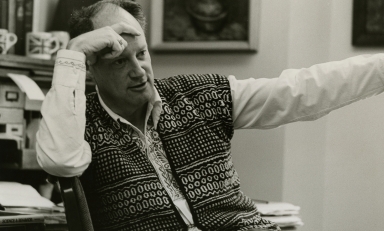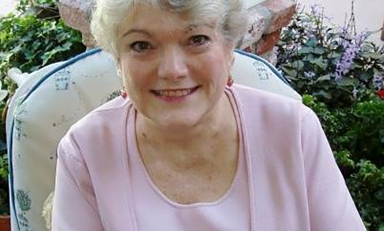Occidental's 11th president arrived on campus in 1988 amid national fanfare and great expectations—and in the 11 years to follow, John Brooks Slaughter brought out the best in Oxy
During his 11 years as president of Occidental College, John Brooks Slaughter habitually took his phone and correspondence to the benches outside of his office in the Arthur G. Coons Administrative Center—so often that trustees installed a plaque that read “John Slaughter Cigar and Conversation Bench” to commemorate his retirement in 1999. As students headed back to their residence halls after their morning classes, he later recalled, “Many of them would come sit down on the benches and we'd talk. And when I think about the joy I had as president of Occidental, the first thing that comes to mind is the opportunities I had to interact with students.”
Slaughter’s affection for his students was reciprocated. “President Slaughter was the man,” former ASOC President and current trustee Leo Olebe ’97 said in a 2021 interview for Occidental magazine. “He had this way of communicating with students and connecting. We felt respected, we felt heard, we felt encouraged to share our ideas. We felt like we were a true and honored part of the Occidental College community.”
“He was such a hero of mine,” said Eddie Jauregui ’98, a first-generation college student from Carson. “President Slaughter had a lot of challenges that were sort of laid at his feet, but I think a lot of students of color in particular really admired that man. I certainly did.”
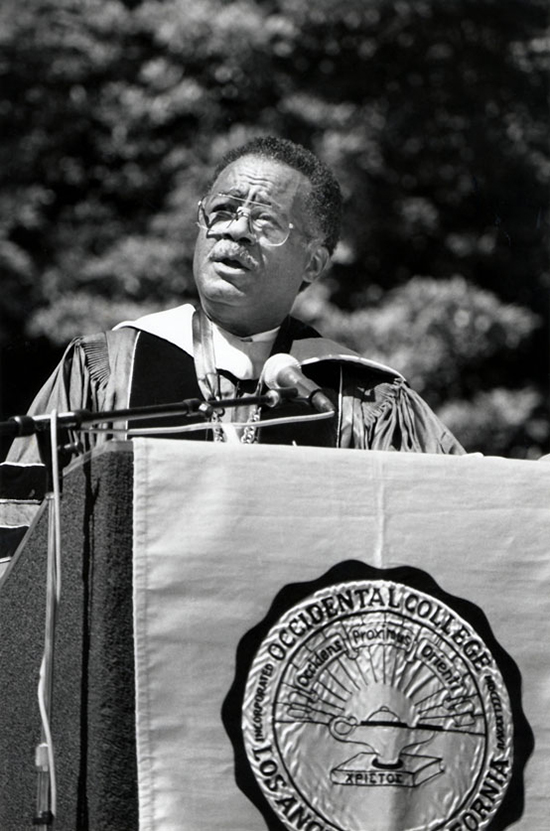
Slaughter—who died on December 6, 2023, at Huntington Hospital in Pasadena, at age 89—cemented his place in Occidental history through his humanity, positivity, and integrity. In his 1988 Convocation address, he told students: “We expect you to dream about a future for this college and this nation that is free of fear, intolerance, and injustice. And we expect you to energize us with your dreams and your enthusiasm for making them come true.”
Over a decade marked by cultural, financial, and philosophical challenges, Slaughter led the College through an extraordinary period of change, transforming the makeup of not only the student body but of the faculty and governing body as well. “Building on work begun by the faculty to diversify curriculum and bring students of color to campus, Slaughter spearheaded a strategic planning process that focused Oxy in a new direction with a mission built on the four cornerstones of excellence, equity, community, and service,” Emerita Professor of Mathematics Nalsey Tinberg wrote in this magazine in 1999.
“I have been blessed to have many opportunities during my professional career to do some things that I've thoroughly enjoyed, but I'm quick to tell people that of all the things that I've done, the 11 years I've served as president at Occidental College was truly the most enjoyable and wonderful period of my professional career,” Slaughter said in a conversation with then-President Jonathan Veitch in April 2012 on the occasion of Occidental’s 125th anniversary.
Whatever the situation, he added, “I always felt that I had a wealth of goodwill from members of the faculty and some amazing students who were there to provide support as well. And I guess that’s why I don't see the bumps as being as high as some people remember.”
In the words of Jonathan Veitch, “There's probably no more important moment in the College's history” than when Slaughter arrived in August 1988. But the Topeka, Kansas, native—coming off a nearly six-year stint as chancellor of the University of Maryland, College Park, initially declined to pursue the Occidental presidency.
“I'd been asked by an Ivy League school to place my name in consideration for president in 1987,” he told Veitch. “I had some concerns about whether or not a private university in the United States at the time was really serious about the possibility of appointing an African American as president, and I did not want to simply be an affirmative action statistic.” After providing his CV and meeting with the search committee, “the outcome of that was pretty much as I had anticipated.”
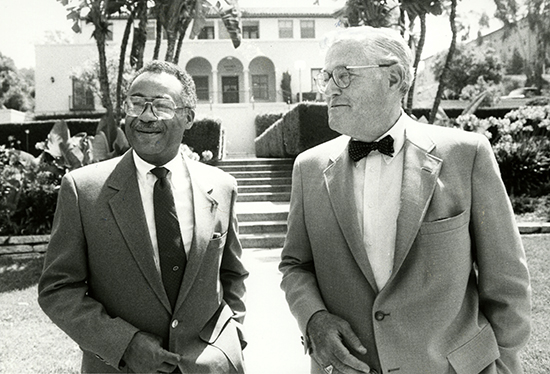
Soon after that, Slaughter received a call from the same search firm, which was now handling the search for a successor to retiring Occidental President Richard C. Gilman. “When I was asked to place my name in contention for Occidental, I refused to do so because I did not want to go through the same experience again,” he recalled. “But they were persistent, and I finally said to the head of the search firm that if Occidental is really serious it will send someone back East to see me, rather than my coming out to Occidental for a visit, and I thought that would be the end of it.”
Much to Slaughter’s surprise, Occidental trustee Donn Miller, who was chairing the search committee, flew out to meet with Slaughter on January 31, 1988—Super Bowl Sunday—at the Four Seasons Hotel in Washington, D.C. “We met for a couple of hours over brunch, and we talked about a lot of things that were of mutual interest to us,” Slaughter said. “I concluded right then and there that I would send my CV for consideration for the Occidental presidency.”
At many major research universities—including the University of Maryland—Slaughter found that the emphasis on graduate education came “somewhat at the expense of undergraduates. I believed very strongly that the most important period in a student’s life in a college or university is that four-year undergraduate experience, and Occidental afforded that opportunity.”
During his initial interview with the full search committee, Slaughter’s exposure to Occidental was limited to a driving tour of campus. “We met at a hotel in Pasadena, so I did not have any real contact with the College or its people except for the trustees, a few faculty members, and a student or two who were on the search committee,” he recalled. “There were several things in that interview that I remember very well. One of the faculty members on the search committee was an African American female, and at one point in a break in my meeting with the search committee, I turned to her and I asked, ‘How many African Americans are on the faculty?’ And she replied, ‘You’re looking at 50 percent of them.’”
At another point, Slaughter continued, “One of the trustees asked me the question, ‘Given that the Board of Trustees is itself not very diverse, do you think that we are appropriately constituted to lead an effort for making Occidental more multicultural?’ My answer was ‘No,’ and there was quiet after that response.”
Later, as Slaughter was being driven to the airport, the head of the search firm laughed and told him, "That same question has been asked to every candidate that we've had and each of them has said ‘Yes.’” Slaughter was going to be Occidental’s next president, he continued, “because they know the answer to that question is not ‘Yes.’”
From the first days of his presidency, Slaughter embraced Occidental’s tradition of outstanding academic achievement while recognizing the mutuality of excellence and equity. At his inauguration in April 1989, he declared, “Quality and equality are inseparable and diversity is synonymous with what is best in America.” With the blessing of Donn Miller, who became chair of the Board of Trustees in 1990, Slaughter led the College through the formulation of a widely accepted strategic plan and mission statement that positioned Occidental to become one of the country’s best and most distinctive liberal arts colleges.
“I could have written initially the strategic plan we ended up with by myself,” Slaughter recalled, “but it would not have had any significance because what we really needed was to build a sense of community on the campus.” The resulting strategic plan, endorsed by faculty in September 1990 and by the Board of Trustees the following month—was called Of Excellence and Equity. (“John Slaughter loved alliteration,” Professor of English Emeritus Eric Newhall ’67 noted in 2021.)
During the Slaughter years, Occidental students won three Rhodes scholarships—ending a 27-year drought—as well as three Trumans, three Marshalls, 18 Goldwaters, 17 NSF fellowships, 15 Watsons, and a host of other national awards. Despite difficult circumstances, including a major earthquake and civil unrest, student applications eventually rose to record levels as the College’s interdisciplinary and multicultural academic programs drew national recognition.
By the time Sam Sharp ’96 arrived at Occidental from a predominantly white school in suburban Denver, he recalled, “More than 50 percent of the [Occidental] student body were students of color and active about issues of equity and justice. And it wasn’t just students of color; the whole campus was active about those issues. President Slaughter’s vision of multiculturalism really permeated the College. And there was no way to be on campus without being inside that vision.”
Slaughter’s vision for Occidental wasn’t universally embraced at the outset. “The biggest problem, frankly, was with alumni who thought of the College as it was in the 1940s and 1950s—the idyllic institution that they wanted it to remain,” he said in 2012. “But if they took a look at the surrounding community, Eagle Rock was becoming much more diverse, with large numbers of Latino persons moving in. I argued that the most important thing that we could do would be for the College to be seen as a major part of that community—to be a place that the citizens of Eagle Rock and Highland Park were proud of—and that was the most important thing we could do in recognizing the changes that were occurring.”
Occidental’s embrace of its neighbors seemed to work. During the citywide uprising that followed the Rodney King verdict in 1992, Slaughter noted, “Many communities erupted, but Occidental College was protected. And that’s because the people who surrounded the College cared for it. They loved it. And I always felt that that was the most important thing that we did at that time was to build that sense of community.”
Other challenges were more institutional in nature. Prior to Slaughter’s arrival, the Board of Trustees had voted to remove the crosses from Herrick Chapel, which was completed in 1964 (the College has been nonsectarian since 1910), and then-Board of Trustees chair Robert Finch ’47 had promised the crosses would be gone before Slaughter arrived. But they didn’t come down until 1989—one of a number of “areas of resistance” that Slaughter encountered when he took office.
Another controversy that Slaughter inherited was apartheid, and the fact that part of Occidental’s endowment was invested in companies doing business in South Africa. (Barack Obama ’83’s first political speech, on the steps of the Arthur G. Coons Administrative Center, took place at an anti-apartheid rally in 1981.).
In response to the ongoing outcry, Slaughter worked with a group of faculty members and students in formulating an argument that he would present to the Board that Oxy divest of any company stock that was doing business in South Africa. “From a symbolic point of view, perhaps more than anything else, I felt that an act on the part of the Board to acknowledge that we would make every effort to divest from those companies, however difficult it might be, would be an important thing to do.”
After Slaughter’s presentation, the board heard “a very impassioned defense of our current position” by one trustee whose company was involved in South Africa, and the motion to divest failed by a single vote. “It was a great learning experience for me,” he said in 2012. “The one thing that I vowed was that I would never take anything to the Board again without confidence that it would pass. I wanted to make sure I did a better job of preparing for that kind of vote.”
In the years to follow, Slaughter’s impact on the College culture would become manifest. He oversaw Compass for a New Century: The Campaign for Occidental, which raised a record $72 million over five years for a variety of academic programs, student scholarships, and construction projects. He spearheaded the opening of the Child Development Center, the rededication of Herrick Chapel and Interfaith Center, the creation of Samuelson Pavilion, and the renovation and expansion of Johnson Student Center.
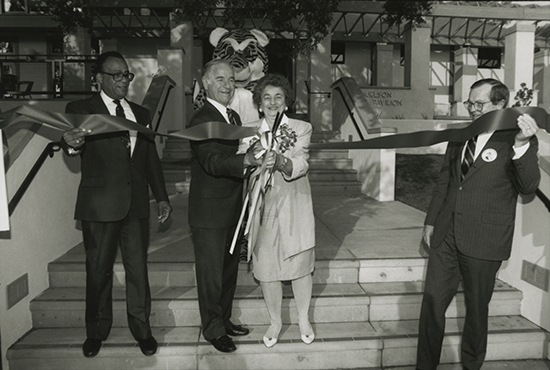
“The one thing that I really wanted to make happen was to remodel Freeman College Union [built in 1928] into a building that would be attractive to incoming students,” Slaughter said. “I always felt that we cost ourselves an enrollment of 10 to 15 percent simply because of the decrepit nature of the student center that existed at the time. That was enough of a turnoff to make it difficult to attract some of the students that we really wanted.”
When U.S. News & World Report began measuring campus diversity in its 1998 rankings, Occidental was No. 1—a status it would retain over the next four years. By the time of Slaughter’s departure in 1999, nearly 25 percent of Oxy’s 118 tenured or tenure-track faculty were nonwhite. (All but three of the College’s tenured faculty were white in 1988.) The Board of Trustees became less homogeneous as well, electing its first female chair, Ginny (Goss) Cushman ’55, in 1996.
Following Slaughter’s retirement from Occidental, he taught courses in diversity and leadership for one year as Irving R. Melbo Professor of Leadership Education at USC before accepting the position of president and CEO of the National Action Council for Minorities in Engineering (NACME), whose mission is to increase the number of engineers of color, in 2000. In January 2010, Slaughter joined USC as professor of education and engineering. He retired in 2022. On September 20, 2023, the USC Viterbi School of Engineering dedicated the new John Brooks Slaughter Center for Engineering Diversity.
In his final Founders Day address in April 1999, Slaughter said: “I have always believed that Occidental’s commitment to a mission that embraced the ideal of the mutuality that exists between excellence and equity began on that April day in 1887. To be sure, the world was different then, the words that were used may have been different then, and the founding fathers of this fledgling college may have envisioned this future through a mirror darkly then, but it is clear that they saw the need for an institution in the still raw City of Angels that someday would emerge as an ‘Oasis of Hope’ for future generations. Occidental College is such a place today, and all who are here can be proud of the roles they have played in making it so.”
Slaughter is survived by his wife, Dr. Bernice Slaughter; son, John II; and daughter, Jacqueline. A celebration of his life and legacy will be held during Homecoming and Family Weekend in October.

